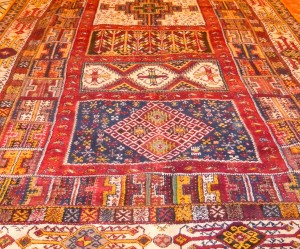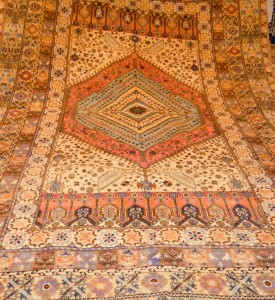For an introduction into design and textiles one can do no better than visit the Tiskwin museum which is near the Dar Si Said in Marrakech. For a first foray into carpets and kelims there are cooperatives such as L’Ensmble des Artisans on Avenue Mohammed V in Marrakech to get an idea of the range of carpets and kelims available and most importantly, the prices before plunging into the souks and the bargaining when traveling to Morocco.
Interior designers like Le Corbusier before the Second World War popularised berber geometric designs which had been passed from generation to generation and were emblematic of the tribes and regions. Carpets with a black background come from the Gloua clan whereas red came from Chichoua on the road from Marrakech to Essaouira.
Moroccan carpets do not match Persian ,Turkish or Chinese for value but their unique identity as an expression of cultural identity and their beauty make them an attractive buy. Moroccan Kelims or flat weave carpets are an excellent buy.
There are now a number of websites offering antique Moroccan carpets, there are naturally fewer of them available. This is a specialist area and you need expert advice.
Rabat carpets are not as old as those which come from the Berber regions. Their exact origins are sometimes disputed. The “r’bati” carpets are reputed to trace their origins to distant Asia Minor. It is said that the Muslims of Andalusia who settled on the banks of the Bou Regreg River after the Spanish Reconquest in 1492 brought with them the designs and skills of producing them.
The oldest examples come from the 18th century, and these are the only Moroccan carpets where the pattern is diametrically different to those of the Berber carpets. The oldest carpets manufactured in Morocco are Taznakht, Zayane and Hanbal, all of which are made in the same region and are a source of pride for the country’s handicraft industry both at home and abroad.
Originally woven in the High Atlas, the Taznakht carpet is made of knots on two lines; their bottom is yellow with dense geometrical drawings which are red, dark green or broken white.
Hanbel is a woven rug, lighter and less thicker than the typical carpet. It is used as a cover for sofas or decoration during national or private feasts. Sometimes, it is used instead of carpets. It is produced in Zayane, Zemmour and Ouazguita.
Either genuine wool or good quality cotton is used to make this type of carpet. Threads are well spinned and clean. The colour of this carpet is red, yellow, green, black and brown. These colours are extracted from the plants in the Hanbel region.Originally made in Berber regions, the hanbal contains patterns whose forms and features are inspired by nature and whose contours are inspired by Amazigh script.
There are little known and more varied flatweaves (often called kilims) from the Middle Atlas Mountains, with some Glawa or Tazenakht pile pieces from the High Atlas south of Marrakesh, especially in the Women Weavers OnLine section. Nearly all the flatweaves are in wool, with white designs (usually in cotton) for contrast, and the pile pieces are usually all wool. Floor pieces range from about 3×5 feet to 5×8 feet, though some are larger. The rectangular shape fits Moroccan rooms, in which many have already been used
What unites all Moroccan carpets is a creative and archaic spirit and a language of rural symbols and motifs. Old tribal carpets can be spontaneous and bold. Some are very plain, others full of complex motifs; some are colourful while other feature subtle hues.
Because old pieces are now so hard to find, co-operatives have sprung up to supply the market with copies, particularly Beni Ouarainss, and reproductions now abound. These can be attractive but cannot replicate the creativity and originality of an old piece, created with care for personal use.
Certain tribes favour certain colours. Natural dyes are usually only found in items over 70-80 years old – almond leaves, cochineal, indigo, iron sulphate and cow urine were all used. Both synthetic and natural dyes fade – with older rugs you can be sure that most of the fading has already occurred.
The complex language of different tribal carpets reveal the richness of berber culture and traditions. Weavings contain important thoughts and ideas. More often than not symbols make reference to the natural world, to fertility, birth, femininity, rural life and to nature as well as to spirituality and beliefs. Many weavers believed that rugs had powers to ward off evil.
For more information about Carpets, Kelims and Textiles or Shopping in the Souks of Morocco






